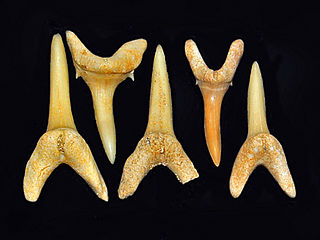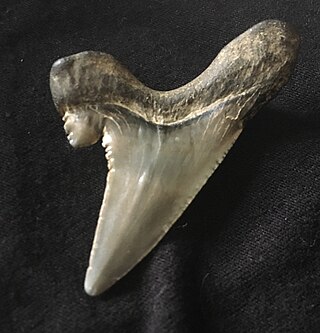
The Lamniformes are an order of sharks commonly known as mackerel sharks. It includes some of the most familiar species of sharks, such as the great white as well as less familiar ones, such as the goblin shark and megamouth shark.

Carcharodon is a genus of sharks within the family Lamnidae, colloquially called the "white sharks." The only extant member is the great white shark. The extant species was preceded by a number of fossil (extinct) species including C. hubbelli and C. hastalis. The first appearance of the genus may have been as early as the Early Miocene or Late Oligocene. Carcharocles megalodon is still argued by some paleontologists to be a close relative of Carcharodon carcharias - as well as being in the same genus. The megalodon's scientific name was originally "Carcharodon" megalodon, but more recently, the giant shark has been assigned by most scientists to either the genus Carcharocles or Otodus.

Otodus megalodon, commonly known as megalodon, is an extinct species of giant mackerel shark that lived approximately 23 to 3.6 million years ago (Mya), from the Early Miocene to the Pliocene epochs. O. megalodon was formerly thought to be a member of the family Lamnidae and a close relative of the great white shark, but has been reclassified into the extinct family Otodontidae, which diverged from the great white shark during the Early Cretaceous.

Physogaleus is an extinct genus of small requiem shark that lived from the Late Paleocene to Miocene epochs.

Otodus is an extinct, cosmopolitan genus of mackerel shark which lived from the Paleocene to the Pliocene epoch. The name Otodus comes from Ancient Greek ὠτ- and ὀδούς – thus, "ear-shaped tooth".

Otodus angustidens is an extinct species of prehistoric megatoothed sharks in the genus Otodus, which lived during the Late Eocene and Miocene epochs about 34 to 21 million years ago. The largest individuals were about 11–12 metres (36–39 ft) long. This shark is related to another extinct megatoothed shark, the famous Otodus megalodon.

Striatolamia is an extinct genus of sharks belonging to the family Odontaspididae. These extinct sharks lived from the Early Paleocene to Late Miocene.

Otodus chubutensis, meaning "ear-shaped tooth of Chubut", from Ancient Greek ὠτ and ὀδούς – thus, "ear-shaped tooth", is an extinct species of prehistoric megatoothed sharks in the genus Otodus, that lived during Oligocene, Miocene, and Pliocene, in ~28–5.3 milions years ago. The largest individuals were about 13.5 metres (44 ft) long. This shark is considered a close relative of the famous prehistoric megatoothed shark O. megalodon. However, as is the case with O. megalodon, the classification of this species is disputed.

Otodontidae is an extinct family of sharks belonging to the order Lamniformes. Its members have been described as megatoothed sharks. They lived from the Early Cretaceous to the Pliocene, and included genera such as Otodus, including the giant megalodon. Recent studies of the newly described genus Megalolamna indicate that the members of the genus Carcharocles should be reclassified as members of the genus Otodus. The genus Cretalamna which lived from the mid-Cretaceous-Paleogene is believed to be directly ancestral to Otodus, and thus to megalodon.

Hemipristis serra is an extinct species of weasel shark which existed during the Miocene epoch. It was described by Louis Agassiz in 1843. While today's snaggletooth shark is not very large or dangerous, Hemipristis serra, which lived in the Atlantic Ocean during the Oligocene and Miocene, was considerably larger than its modern-day relative and had much larger teeth. Its total length is estimated to be 6 metres (20 ft). Marks made by the teeth of H. serra are often found on the bones of the dugong Metaxytherium leading some scientists to hypothesize that H. serra specialized in preying on these sirenians. In the Gatun Formation of Panama, H. serra was contemporary with pups of the large lamniform shark Otodus megalodon, and both it and the great hammerhead are theorized to have preyed on the pups of this larger shark due to their presence within the formation.

Otodus auriculatus is an extinct species of large sharks in the genus Otodus of the family Otodontidae, closely related to the sharks of the genus Otodus, and also closely related to the later species megalodon. The largest individuals were about 9.5 metres (31 ft) long. Its teeth were large, having coarse serrations on the cutting edge, and also with two large cusplets. The teeth can reach up to 130 millimetres (5.1 in), and belonged to a large "megatoothed" shark.

Carcharodon hubbelli, also known as Hubbell's white shark, is an extinct species of white shark that evolved between 8 and 5 million years ago during the Late Miocene to Early Pliocene epochs. This shark is a transitional species, showing intermediate features between the extant great white shark and the fossil white shark, C. hastalis. C. hubbelli appears to be geographically restricted to the Pacific Ocean, with fossils of C. hubbelli recovered from Peru, Chile, California, and New Zealand. This exclusive distribution suggests a Pacific origin for the great white shark.
The Temblor Formation is a geologic formation in California. It preserves fossils dating back from the Late Oligocene to the Middle Miocene of the Neogene period. It is notable for the famous Sharktooth Hill deposit.

Cosmopolitodus is an extinct genus of mackerel shark that lived between thirty and one million years ago during the late Oligocene to the Early Pleistocene epochs. Its type species is Cosmopolitodus hastalis, the broad-tooth mako. In 2021, Isurus planus was reassigned to the genus, and thus became the second species C. planus. However, some researchers still consider both species of Cosmopolitodus as species of Carcharodon.
Megalolamna is an extinct genus of lamniform shark that belongs to the family Otodontidae. Its name comes from the similarity of its teeth to those of the extant shark genus Lamna. It is known from the early Miocene Chilcatay Formation of Peru, Oi and O'oshimojo Formations of Japan, and the Jewett Sand Formation of California and Pungo River Formation, North Carolina in the United States, implying a cosmopolitan distribution. The largest specimen is estimated to have measured about 5.1 metres (17 ft) long.

Alopias palatasi, commonly referred to as the serrated giant thresher, is an extinct species of giant thresher shark that lived approximately 20.44 to 13.7 million years ago during the Miocene epoch, and is known for its uniquely serrated teeth. It is only known from such isolated teeth, which are large and can measure up to an excess of 4 centimetres (2 in), equating to a size rivaling the great white shark, but are rare and found in deposits in the East Coast of the United States and Malta. Teeth of A. palatasi are strikingly similar to those of the giant thresher Alopias grandis, and the former has been considered as a variant of the latter in the past. Scientists hypothesized that A. palatasi may have had attained lengths comparable with the great white shark and a body outline similar to it.

Otodus aksuaticus is an extinct species of large shark in the family Otodontidae which may represent a transitional species between Otodus obliquus and Otodus auriculatus. They are similar in overall morphology to Otodus obliquus except they have serrations on their cusps and blade. It is sometimes placed in the genus Otodus. It is mainly found in the Ypresian stage of the Eocene epoch. They have been found in the Woodstock Member of the Nanjemoy Formation of Maryland and Virginia and Ypresian sediments in Aktulagay, Kazakhstan as well as the Ypres clay in Belgium and the London Clay in the United Kingdom.

Otodus sokolovi is an extinct species or chronospecies of large shark in the family Otodontidae which may represent a transitional chronospecies between Otodus auriculatus and Otodus angustidens. They differ from the former with a less curved root and finer serrations and from the latter with more prominent and recurved cusps. Due to the subtle differences, it is sometimes lumped into O. auriculatus. It, along with the rest of Otodus, is sometimes placed in the genus Carcharocles. Due to its similarities with other chronospecies, it is difficult to tell exactly when it arose and went extinct. Generally, it is said to span from the late Eocene to early Oligocene. They are best known from the late Eocene localities around Dakhla, Morocco and Fayum, Egypt but are represented in many deposits of contemporary age. It measured at least 6 metres (20 ft) long.

The Calvert Formation is a geologic formation in Maryland, Virginia, and Delaware. It preserves fossils dating back to the early to middle Miocene epoch of the Neogene period. It is one of the three formations which make up the Calvert Cliffs, all of which are part of the Chesapeake Group.
Cetorhinus huddlestoni is extinct species of basking shark that lived in the Middle miocene period. Its fossils consist of juvenile specimens, represented by fragmented and complete teeth. They are believed to be the same size as the current basking shark. It was discovered in the Shark tooth Formation by Welton in 2013.
















